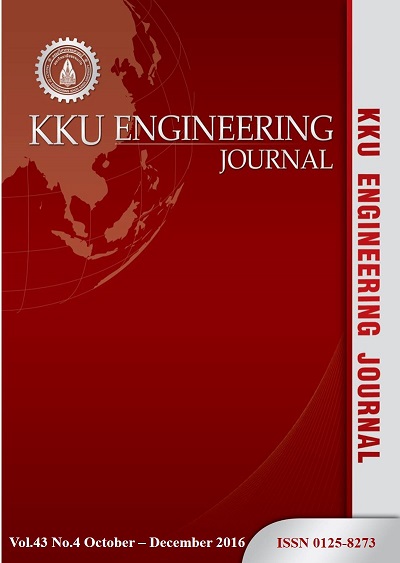Preparation of platinum-free tubular dye-sensitized solar cells by electrophoretic deposition
Main Article Content
Abstract
Article Details
This work is licensed under a Creative Commons Attribution-NonCommercial-NoDerivatives 4.0 International License.
References
Okada K, Matsui H, Kawashima T, Ezure T, Tanabe N. 100mm100 mm large-sized dye-sensitized solar cells. J Photochem Photobiol. 2004;A164:193-8.
Lee WJ, Ramasamy E, Lee DY, Song JS. Dye-sensitized solar cells: scale up and current–voltage characterization. Sol Energy Mater Sol Cells. 2007;91:1676-80.
Tachan Z, Ruhlr S, Zaban A. Dye-sensitized solar cell tubes: a new solar cell design for efficient current collection and improved cell sealing. Sol Energy Mater Sol Cells. 2010;94:317-22.
Fan X, Chu Z, Wang F, Zhang C, Chen L, Tang Y, Zou D. Wire-shaped flexible dye-sensitized solar cells. Adv Mat. 2008;20:592-5.
Fu Y, Lv Z, Wu H, Hou S, Cai X, Wang D, Zou D. Dye-sensitized solar cell tube. Sol Energy Mater Sol Cells. 2012;102:212-9.
Lv Z, Fu Y, Hou S, Wang D, Wu H, Zhang C, Chu Z, Zou D. Large size, high efficiency fiber-shaped dye-sensitized solar cells. Phys Chem Chem Phys. 2011;13:10076-83.
Kay A, Gratzel M. Low cost photovoltaic modules based on dye sensitized nanocrystalline titanium dioxide and carbon powder. Sol Energy Mater Sol Cells. 1996;44:99-117.
Suzuki K, Yamaguchi M, Kumagai M, Yanagida S. Application of carbon nanotubes to counter electrodes of dye-sensitized solar cells. Chem Lett. 2003;32:28-9.
Imoto K, Takahashi K, Komura T, Nakamura J, Murata K. High-performance carbon counter electrode for dye-sensitized solar cells. Sol Energy Mater Sol Cells. 2003;79:459-69.
Saito Y, Kitamura T, Wada Y, Yanagida S. Poly(3,4-ethylenedioxythiophene) as a hole conductor in solid state dye sensitized solar cells. Synth Met. 2002;13:185-7.
Li Q, Wu J, Tang Q, Lan Z, Li P, Lin J, Fan L. Application of microporous polyaniline counter electrode for dye-sensitized solar cells. Electrochem Commun. 2008;10:1299-302.
Maiaugree W, Pimanpang S, Towannang M, Saekow S, Jarernboon W, Amornkitbamrung V. Optimization of TiO2 nanoparticle mixed PEDOT–PSS counter electrodes for high efficiency dye sensitized solar cell. J Non Cryst Sol. 2012;358:2489-95.
Jarernboon W, Pimanpang S, Maensiri S, Swatsitang E, Amornkitbamrung V. Optimization of titanium dioxide film prepared by electrophoretic deposition for dye-sensitized solar cell application. Thin Solid Films. 2009;517:4663-7.
Miyasaka T, Kijitori Y, Murakami T.N, Kimura M, Uegusa S. Efficient nonsintering type dye-sensitized
photocells based on electrophoretically deposited TiO2 layers. Chem Lett. 2002;12:1250-51.
Miyasaka T, Kijitori Y. Low-temperature fabrication of dye-sensitized plastic electrodes by electrophoretic preparation of mesoporous TiO2 layers. J Electrochem Soc. 2004;151:1767-73.
Yum J.H, Kim S.S, Kim D.Y, Sung Y.E. Electrophoretically deposited TiO2 photo-electrodes for use in flexible dye-sensitized solar cells. J Photochem Photobiol A. 2005;173:1-6.
Yun H, Kim M, You I. Tuned optical reflection characteristics of chemically-treated Ti Substrates. ETRI J. 2012;34:954-7.
Sutter E.M.M, Goetz-Grandmont G.J. The Behavior of Titanium in Nitric-Hydrofluoric Acid Solutions. Corro Sci 1990;30:461-476.
Yun HG, Bae BS, Kang MG. A simple and highly efficient method for surface treatment of Ti substrates for use in dye-sensitized solar cells. Adv Energy Mater. 2011;1:337-42.
Lee SU, Choi W.S, Hong B. A comparative study of dye-sensitized solar cells added carbon nanotubes to electrolyte and counter electrodes. Sol Energy Mater Sol Cells. 2010;94:680-5.
Gao F, Wang Y, Zhang J, Shi D, Wang M, Humphry-Baker R, Wang P, Zakeeruddin S, Grätzel M. A new heteroleptic ruthenium sensitizer enhances the absorptivity of mesoporous titania film for a high efficiency dye-sensitized solar cell. Chem Commu. 2008;23:2635-7.



